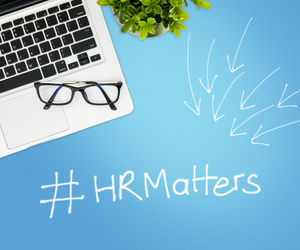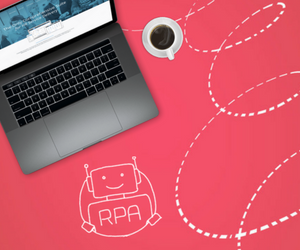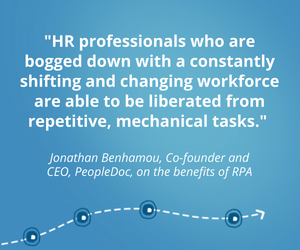 By now, you’re likely aware of the benefits AI can bring to the workplace. It’s hard to say augmenting our teams with tools that eliminate mundane tasks or help inform strategic decisions is a bad thing. But, getting started with AI is easier said than done. According to Bersin by Deloitte, 72% of organizations say that AI, robotics and automation are important, but only 31% feel prepared to implement those technologies. Why the gap? Below are some of the biggest obstacles holding HR back from diving head-first into these technologies and what they can do to prepare for the day they’re ingrained in our day-to-day work.
By now, you’re likely aware of the benefits AI can bring to the workplace. It’s hard to say augmenting our teams with tools that eliminate mundane tasks or help inform strategic decisions is a bad thing. But, getting started with AI is easier said than done. According to Bersin by Deloitte, 72% of organizations say that AI, robotics and automation are important, but only 31% feel prepared to implement those technologies. Why the gap? Below are some of the biggest obstacles holding HR back from diving head-first into these technologies and what they can do to prepare for the day they’re ingrained in our day-to-day work.
Adopt new ways of working
According to the study AI at Work, 90% of HR leaders are concerned they won’t be able to adjust to the rapid speed of AI adoption. It’s a legitimate fear considering HR is used to relying on best practices, but the speed of technology is moving faster than best practices can evolve. As there’s yet to be a handbook for AI, HR has no other choice but to experiment, learn and iterate as quickly as possible so they can figure out what works best for their organization.
For this to be feasible for HR, they will have to work differently than they have in the past. They will need to be more nimble and responsive so they can quickly adapt to change.
To prepare, HR can borrow from the software world. The principles of agile project management espouse working in short cycles, regularly reflecting on progress, collaborating and frequently course-correcting based on data and feedback. These practices prevent HR from going too far down a path that may not work for their organization’s unique combination of people and processes.
 Agile principles not only help HR teams employ new technology, they benefit HR workflows and processes across the board. In an increasingly globalized world, HR often finds itself managing both global and regional policies and regulations. Agile HR teams are better able to quickly respond to business or legal changes, and therefore better prepared when it comes to compliance.
Agile principles not only help HR teams employ new technology, they benefit HR workflows and processes across the board. In an increasingly globalized world, HR often finds itself managing both global and regional policies and regulations. Agile HR teams are better able to quickly respond to business or legal changes, and therefore better prepared when it comes to compliance.
Identify high-impact use cases
To get resources for AI technology, HR will be challenged to zero in on applications that will have meaningful impact on the business. The benefits for functions such as Talent Acquisition usually dominate the headlines, such as algorithms that can analyze résumés and video interviews to help HR select the right candidates. But, for functions like HR Service Delivery or HR Operations, there isn’t as much hype around the use cases. That doesn’t mean the impact on the business is any less. In fact, these functions are especially ripe for AI considering they’re more often burdened by repetitive, time-consuming tasks, such as responding to Tier 0, or basic, requests.
To prepare to build the business case for AI investment, HR can start dedicating time now to evaluating their current processes. Which ones are particularly painful or time consuming for HR or employees to complete? If the process of requesting maternity leave is long and confusing for employees, not only does that impinge on the overall employee experience, it eats up time they would otherwise spend on the work they were actually hired to do.
Consider all the innocuous tasks HR teams have to do, such as classifying documents. In isolation, the time this action takes may not seem significant, but when multiplied by the number of times HR files a document over the course of a year, it’s easier to imagine all that could be done with that time instead. These types of actions can easily be handed over to AI.
Identifying the right use cases for AI technology comes down to anything that enhances the productivity of your people. For HR Services, the less time employees spend navigating multiple forms, systems, and points of contact, the more time they have for work that directly supports business objectives.
Get comfortable with RPA
For many organizations, the idea of an employee asking a virtual assistant, “I need to relocate to the Paris office, where do I start?” can seem far-fetched if they haven’t already implemented automatic processes that respond to and resolve these kinds of requests. It’s not a requirement for HR to take incremental, successive steps to implementing AI, but getting comfortable with less complex technologies, like robotic process automation (RPA), can certainly enhance HR’s preparedness.
RPA alone can help HR gain efficiencies as AI continues to be tested and refined. While true AI is meant to mimic human intelligence and reasoning, RPA mimics human behavior. It can automate repeatable tasks without the need for human intervention, such as data entry, clicking buttons, opening programs and generating documents.
 In the case of onboarding, instead of having to manually update the applicant tracking system after a new hire, make a new employee record for the employee database, gather employee documentation and create a new employee in the payroll system, RPA can act on HR’s behalf to complete these tasks in their respective systems. “AI doesn’t make as much sense for streamlining processes as RPA does. The learning is extremely complex. If every employee profile is different, there’s not much that a machine can learn and apply. That’s why automation is the most practical solution,” says Jonathan Benhamou, Co-founder and CEO of PeopleDoc.
In the case of onboarding, instead of having to manually update the applicant tracking system after a new hire, make a new employee record for the employee database, gather employee documentation and create a new employee in the payroll system, RPA can act on HR’s behalf to complete these tasks in their respective systems. “AI doesn’t make as much sense for streamlining processes as RPA does. The learning is extremely complex. If every employee profile is different, there’s not much that a machine can learn and apply. That’s why automation is the most practical solution,” says Jonathan Benhamou, Co-founder and CEO of PeopleDoc.
Though RPA has many benefits on its own, its power is only strengthened when combined with AI. In some cases, AI may complement RPA for smart process orchestration. Bots will be able to make recommendations for better processes, or independently initiate actions based on certain behaviors within a system. When RPA and AI work together, that’s when HR has the opportunity to improve productivity by leaps and bounds.
It’s no argument that the world of AI poses some exciting possibilities that can translate to dramatic productivity gains for HR. But to be able to fully embrace all that AI can offer, HR will need to adapt the way they currently work; hone in on use cases that will have the greatest potential for ROI; and take full advantage of current technologies, like RPA, that can help build a bridge to AI.
![]()

